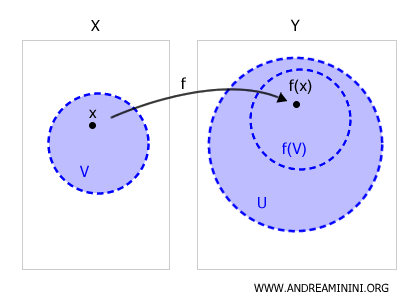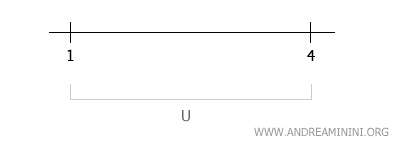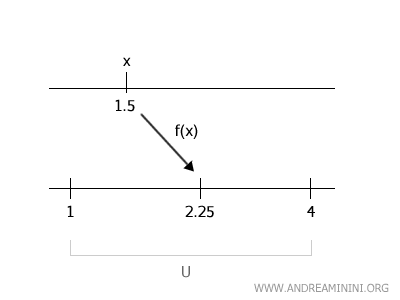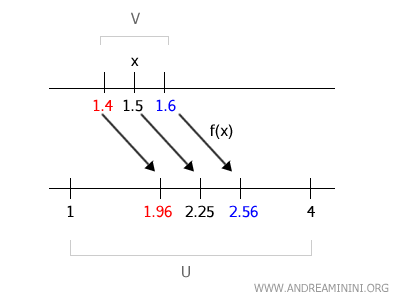Continuity Definition Using Open Sets
A function \( f : X \to Y \) is continuous if and only if, for every point \( x \in X \) and every open set \( U \subset Y \) containing \( f(x) \), there exists a neighborhood \( V \) of \( x \) such that \( f(V) \subset U \).
In simpler terms, a function \( f: X \to Y \) is continuous if, for every open set \( U \subset Y \), the preimage \( f^{-1}(U) \) is an open set in \( X \).

Continuity means that the preimage of any open set in the codomain is always an open set in the domain.
This theorem provides a topological definition of continuity, relying on the concept of open sets in both the domain and codomain.
It's also referred to as the open set definition of continuity.
Note: This theorem is also known as the "equivalence of definitions of continuity" because it shows that the two ways to define continuity for a function—the one with open sets (topological) and the analytical one with \(\varepsilon\)-\(\delta\)—are equivalent. The analytical definition of continuity is the following: "A function \( f \) is continuous at a point \( x_0 \in \mathbb{R} \) if, for every \(\varepsilon > 0\), there exists a \(\delta > 0\) such that for every \( x \in \mathbb{R} \), if \( |x - x_0| < \delta \), then \( |f(x) - f(x_0)| < \varepsilon \)," which is commonly covered in introductory calculus courses.
The opposite is also true: continuity can equally be defined using closed sets.
Given two topological spaces \( X \) and \( Y \), a function \( f: X \to Y \) is continuous if and only if the preimage \( f^{-1}(C) \) of every closed set in \( Y \) is also a closed set in \( X \).
Thus, the concept of continuity can be described in terms of either open or closed sets, as the properties of openness and closedness are inherently linked in topology.
A Practical Example
Consider the function \( f : \mathbb{R} \to \mathbb{R} \) defined as \( f(x) = x^2 \).
We want to determine whether this function is continuous using the open set definition from the theorem.
According to the open set definition of continuity:
A function \( f \) is continuous if, for every open set \( U \subset \mathbb{R} \) and for every \( x \in f^{-1}(U) \), there exists a neighborhood \( V \) of \( x \) such that \( f(V) \subset U \).
Let's choose an open set \( U \subset \mathbb{R} \).
For example, take the open set \( U = (1, 4) \), which includes all the numbers between 1 and 4.

We want to check if \( f^{-1}(U) \), the set of numbers in \( \mathbb{R} \) that are mapped into the interval \( (1, 4) \) by \( f(x) = x^2 \), is open.
To find \( f^{-1}(U) \), we need to determine which values of \( x \) satisfy \( x^2 \in (1, 4) \). In other words, we are looking for \( x \) such that:
$$ 1 < x^2 < 4 $$
This inequality leads to:
$$ 1 < |x| < 2 $$
Therefore, \( x \) must lie within the interval \( (-2, -1) \cup (1, 2) \).
This is the set \( f^{-1}(U) \), which is clearly an open set in \( \mathbb{R} \).
Now, let’s verify the continuity.
We select any point \( x \in f^{-1}(U) \), where \( U = (1, 4) \). For example, take \( x = 1.5 \).
The image of \( x = 1.5 \) is \( f(1.5) = 1.5^2 = 2.25 \), which is within the interval \( U = (1, 4) \).

We now need to find a neighborhood \( V \) around \( x = 1.5 \) such that \( f(V) \subset (1, 4) \).
Let’s choose a small interval around \( 1.5 \), say \( V = (1.4, 1.6) \).

By calculating the values of \( f(x) = x^2 \) for \( x \in (1.4, 1.6) \), we get:
$$ f(1.4) = 1.4^2 = 1.96 \quad \text{and} \quad f(1.6) = 1.6^2 = 2.56 $$
The interval \( f(V) = (1.96, 2.56) \) is entirely contained within the open interval \( U = (1, 4) \).
$$ f(V) \subset U $$
This demonstrates that for every point \( x \in f^{-1}(U) \), there is a neighborhood \( V \) of \( x \) such that \( f(V) \subset U \), satisfying the definition of continuity.
The same holds for any other point \( x \in \mathbb{R} \), confirming that the function \( f(x) = x^2 \) is continuous according to the open set definition of continuity.
Note: Continuity must be verified for all points \( x \in X \). It’s not enough to check the condition at a single point. This is because the continuity of a function is a global property—it must hold at every point in the domain. To prove that a function \( f : \mathbb{R} \to \mathbb{R} \) is continuous, we need to show that for every point \( x \in \mathbb{R} \) and for every open set \( U \) containing \( f(x) \), there exists a neighborhood \( V \) of \( x \) such that \( f(V) \subset U \).
Proof
The proof is divided into two parts:
A] First Part
Assume the function \( f \) is continuous according to the open set definition.
We choose a point \( x \in X \) and an open set \( U \subset Y \) such that \( f(x) \in U \).
Now, we define \( V = f^{-1}(U) \), which is the set of all points in \( X \) that map into \( U \) under \( f \).
Since \( f \) is continuous by the open set definition, we know that \( V \) is an open set in \( X \).
Thus, because \( x \in V \) and \( f(V) \subset U \), we have shown that for every open set \( U \) in \( Y \) containing \( f(x) \), there is an open set \( V \) in \( X \) containing \( x \).
B] Second Part
Assume that for every point \( x \in X \) and for every open set \( U \subset Y \) containing \( f(x) \), there is a neighborhood \( V \) of \( x \) such that \( f(V) \subset U \).
We need to prove that \( f^{-1}(W) \) is open in \( X \) for every open set \( W \subset Y \).
In other words, we need to show that the set of points in \( X \) that are mapped into \( W \) by \( f \) is open.
We take a point \( x \in f^{-1}(W) \), meaning a point \( x \) in \( X \) such that \( f(x) \in W \).
Since \( f(x) \in W \) and \( W \) is open, by assumption, there exists a neighborhood \( V_x \) of \( x \) in \( X \) such that \( f(V_x) \subset W \).
This means that \( V_x \subset f^{-1}(W) \), so \( f^{-1}(W) \) contains an open neighborhood \( V_x \) around \( x \).
Because \( x \) was arbitrary, we can conclude that \( f^{-1}(W) \) is open in \( X \).
Conclusion
In conclusion, the two definitions of continuity—using open sets and using neighborhoods—are equivalent.
And so on.
